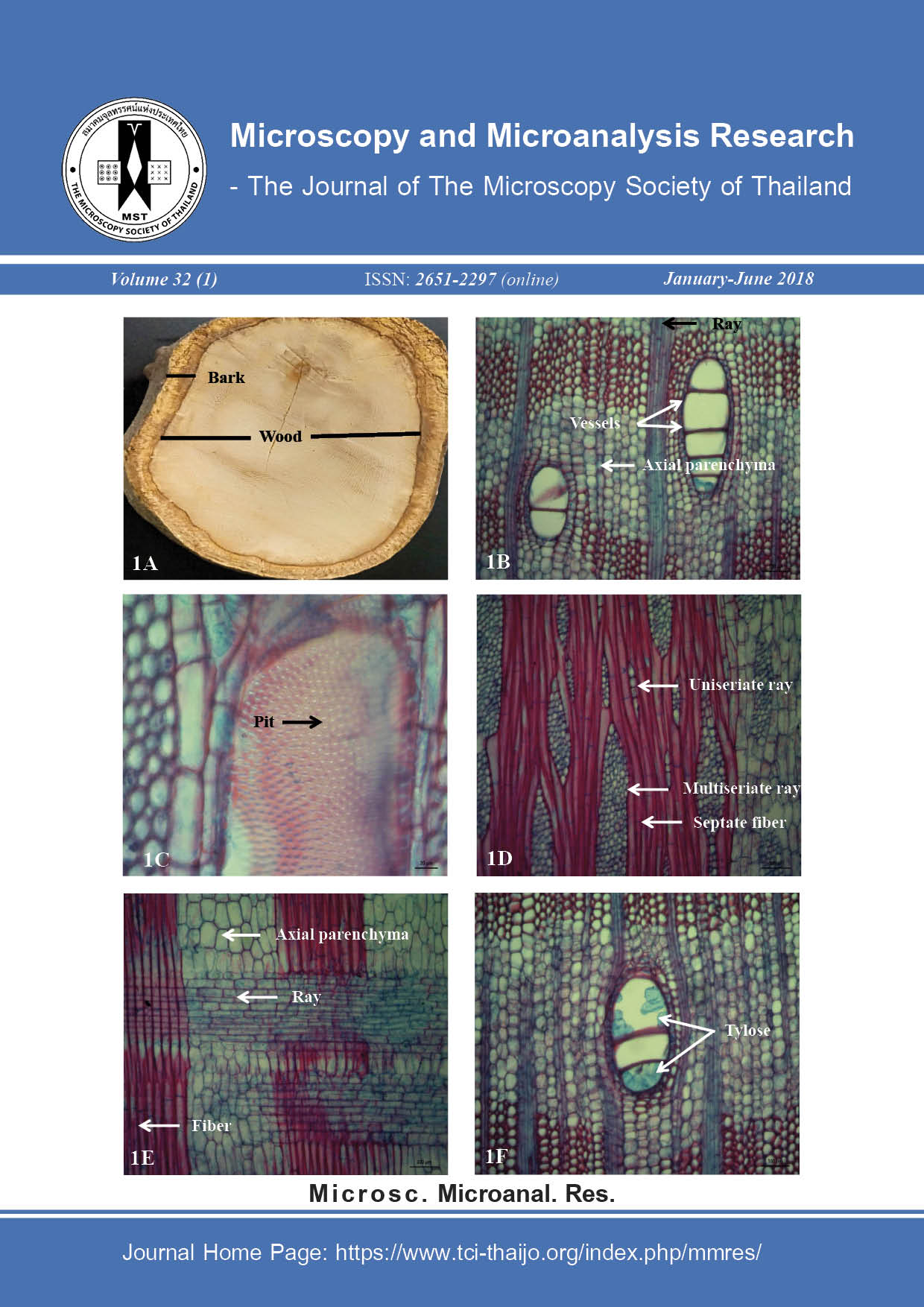Prevalence and Morphological Changes on Fish Gills of Cyprinoid Fish Infected with Centrocestus formosanus Metacercariae from Li River, Lamphun Province
Main Article Content
Abstract
Centrocestus formosanus has been reported to infect the natural fish gill in Northern Thailand. Their infection can cause disease and death. We aimed to study the prevalence and observe morphological changes on fish gill of Siamese glassfish (Parambassis siamensis) and Burmese Trout (Raiamas guttatus) infected with C. formosanus metacercariae by using light microscope and long-section. Fish specimens were caught from Li River in Lamphun province, the North of Thailand. The result revealed the oval-shaped metacercaria attaching on both fish species gills. The metacercaria was identified to be C. formosanus based on 32 circumoral spines and X-shaped excretory bladder. The prevalence, intensity and abundance of C. formosanus infection in Parambassis siamensis were 74.3%, 25.6 metacercaria/fish and 19 metacercaria/fish, respectively. The C. formosanus infection of Raiamas guttatus was lower than Parambassis siamensis in all parameters that included 54.3% of prevalence, 5.7 of intensity and 3.1 of abundance. The infection of C. formosanus in R. guttatus was the first record in the northern part of Thailand. For the pathological observation on fish gill tissue in both species, the result showed the C. formosanus metacercaria attached on the middle of primary gill lamella. The metacercaria was surrounded by thick refractile capsule which caused the fusion of two primary gill lamellae. This gill lamella was thick and distorted in shape that affected the cartilage proliferation, hyperplasia and reduction of gas on the surface. Finally, these morphological changes leaded to death in fish.
Article Details
References
[2] J.Y. Chai, E.H. Shin, S.H. Lee, H.J. Rim, Foodborne intestinal flukes in Southeast Asia, Korean J Parasitol, 2009, 47 (suppl), 69-102.
[3] J.Y. Chai, W.M. Sohn, T.S. Yong, K.S Eom, D.Y. Duk-Young Min, M.Y. Lee, H. Lim, B. Insisiengmay, B. Phommasack, H.J. Rim, Centrocestus formosanus (Heterophyidae): human infection and the infection source in Lao PDR, J Parasitol, 2013, 99, 531-536.
[4] E.T. Han, E.H. Shin, S. Phommakorn, B. Sengvilaykham, J.L. Kim, H.J. Rim, J.Y. Chai, Centrocestus formosanus (Digenea: Heterophyidae) encysted in the freshwater fish, Puntius brevis from Lao PDR, Korean J Parasitol. 2008, 46, 49-53.
[5] H.A. Pinto, A.L. Melo, Metacercariae of Centrocestus formosanus (Trematoda: Heterophyidae) in Australoheros facetus (Pisces: Cichlidae) in Brazil, Rev Bras Parasitol Vet, 2012, 21, 334-337.
[6] C. Wongsawad, P. Wongsawad, K. Sukontason, W. Maneepitaksanti, N. Nantarat, Molecular Phylogenetics of Centrocestus formosanus (Digenea: Heterophyidae) Originated from Freshwater Fish from Chiang Mai Province, Thailand, Korean J Parasitol, 2017, 55, 1, 31-37.
[7] A. Wanlop, C. Wongsawad, P. Prattapong, P. Wongsawad, T. Chontananarth, J.Y. Chai, Prevalence of Centrocestus formosanus Metacercariae in Ornamental Fish from Chiang Mai, Thailand, with Molecular Approach Using ITS2, Korean J Parasitol, 2017, 55, 4, 445-449.
[8] A. J. Mitchell, A. E. Goodwin, M. J. Salmon, T. M. Brandt, Experimental infection of an exotic heterophyid trematode, Centrocestus formosanus, in four aquaculture fishes. N Am J Aquac., 2002, 64, 55-59.
[9] E. Gjurčević, Z. Petrinec, Z. Kozariž, S. Kužir, K.V. Gjurčević, M. Vučemilo, P. Džaja, Metacercariae of Centrocestus formosanus in goldfish (Carassius auratus L.) imported into Croatia, Helminthologia, 2007, 4, 214-216.
[10] S.M. Mood, H.A.E. Mousavi, B. Mokhayer, M. Ahmadi, M. Soltani, I. Sharifpour, Centrocestus formosanus metacercarial infection of four ornamental fish species imported into Iran, Bull. Eur. Ass. Fish Pathol, 2010, 30, 4, 146-149.
[11] A. J. Mitchell, M. J. Salmon, D. G. Huffman, A. E. Goodwin, T.M. Brandt, Prevalence and pathogenicity of a heterophyid trematode infecting the gills of an endangered fish, the fountain darter, in two central Texas spring-fed rivers, J Aquat Anim Health., 2000, 12, 283-289.
[12] R.E. Olson, J.R. Pierce, A Trematode Metacercaria Causing Gill Cartilage Proliferation in Steelhead Trout from Oregon, J Wildl Dis, 1997, 33, 4, 886-890.
[13] J. Waikagul, T. Wongsaroj, P. Radomyos, V. Meesomboon, R. Praewanich, P. Jongsuksuntikul, Human infection of Centrocestus caninus in Thailand. Southeast Asian J Trop Med Public Health, 1997, 28, 831-835.
[14] T. Chontananarth1, C. Wongsawad, Epidemiology of cercarial stage of trematodes in freshwater snails from Chiang Mai province, Thailand, Asian Pac J Trop Biomed, 2013, 3, 3, 237-243.
[15] V.G.V. Paller, S. Uga, Attachment and penetration of Centrocestus armatus (Digenea: Heterophyidae) cercariae to gills of secondary intermediate fish hosts, J Parasitol, 2008, 9, 578-583.
[16] A. J. Mitchell, R. M. Overstreet, A. E. Goodwin, T. M. Brandt, Spread of an exotic fish-gill trematode: A far-reaching and complex problem, Fisheries, 2005, 30, 11-16
[17] V.S. Blazer, J.B. Gratzek, Cartilage proliferation in response to metacercarial infections of fish gills, J Comp Pathol., 1985, 95, 273-280.
[18] E.M.F. Vélez-Hernández, L.J. Constantino-Casas, García-Márquez, O. Sarabia, Gill lesions in common carp, Cyprinus carpio L., in Mexico due to the metacercariae of Centrocestus formosanus, J Fish Dis., 1998, 21, 229-232.
[19] H.A. Yildiz, Infection with metacercariae of Centrocestus formosanus (Trematoda:Heterophyidae) in ornamental fish imported into Turkey, Bull. Eur. Ass. Fish Pathol, 2005, 25, 5, 244-246.


